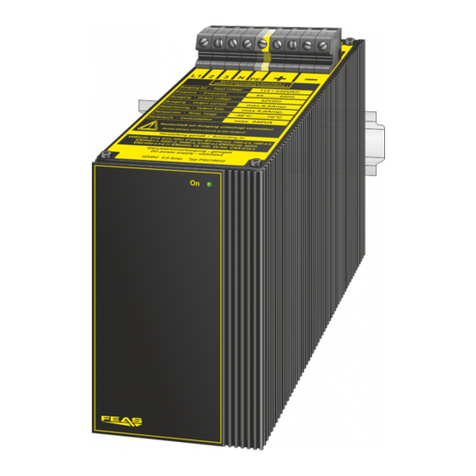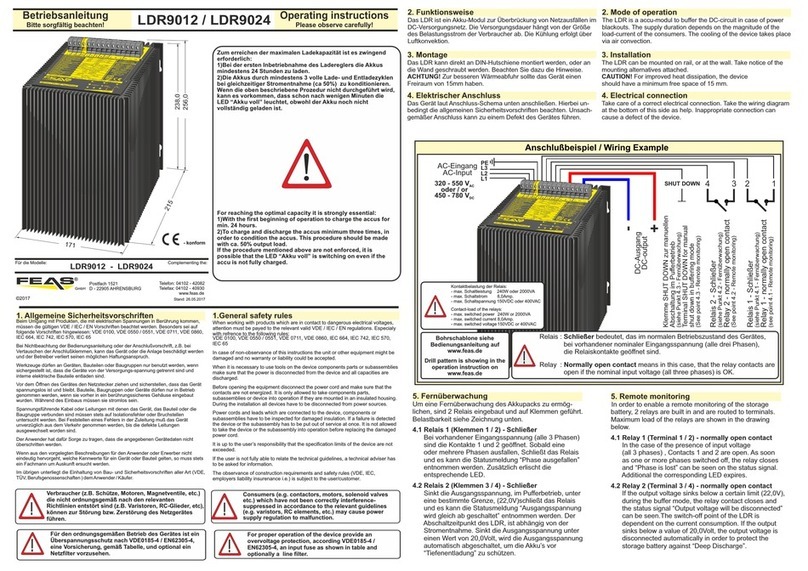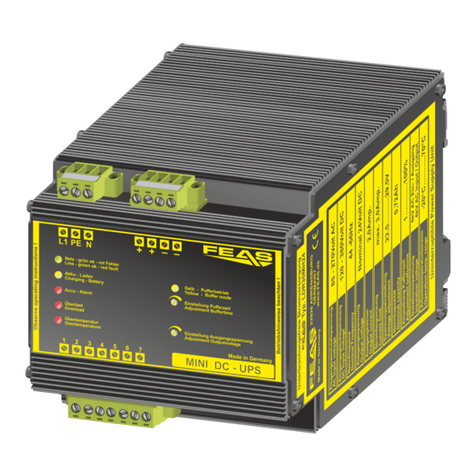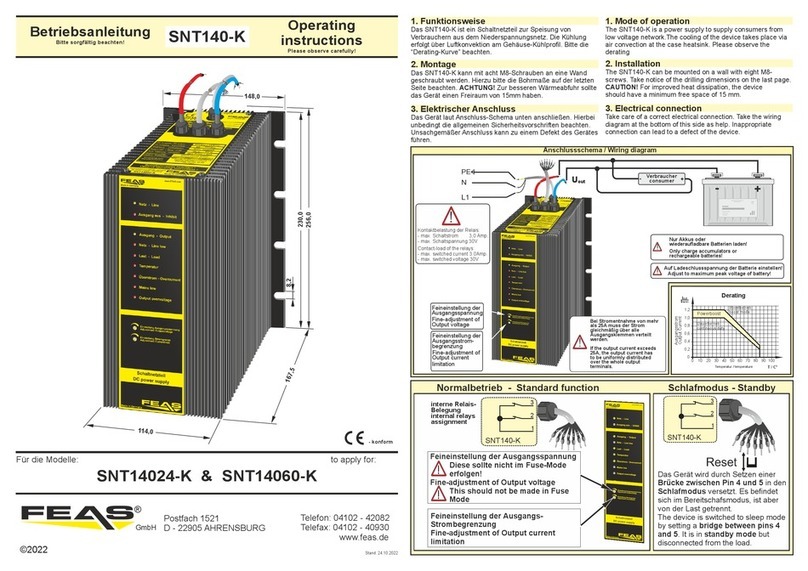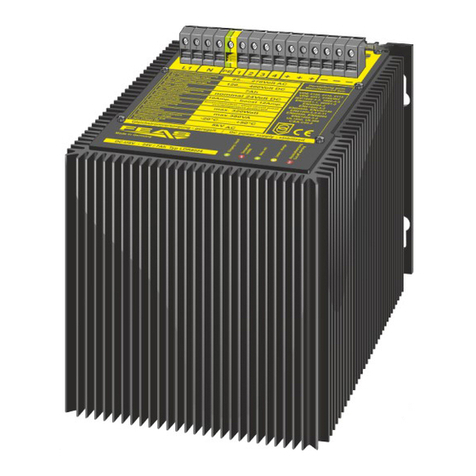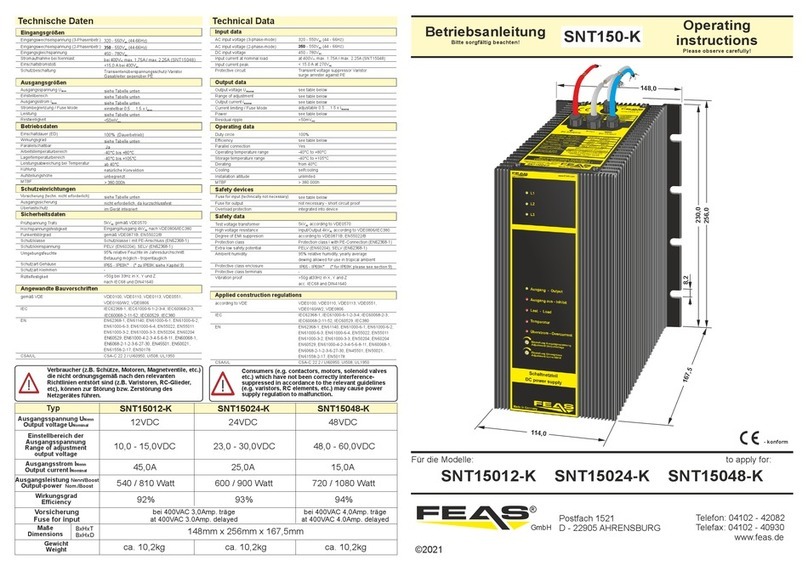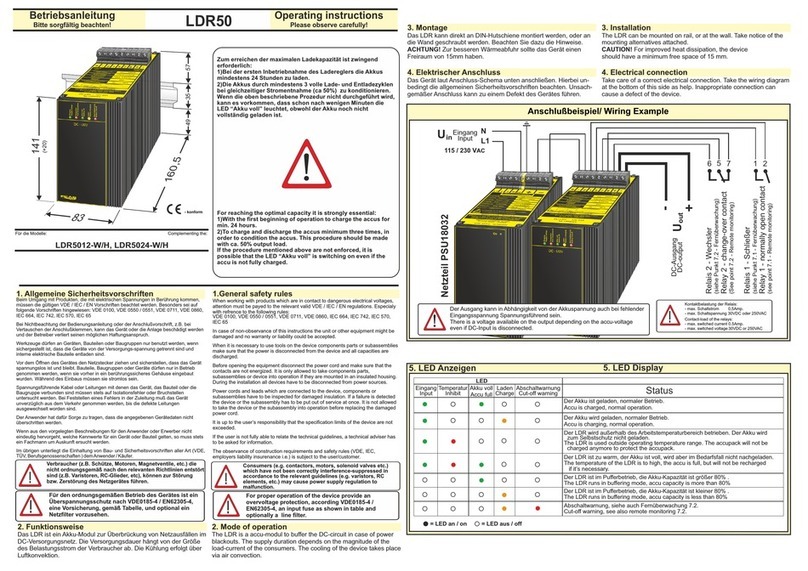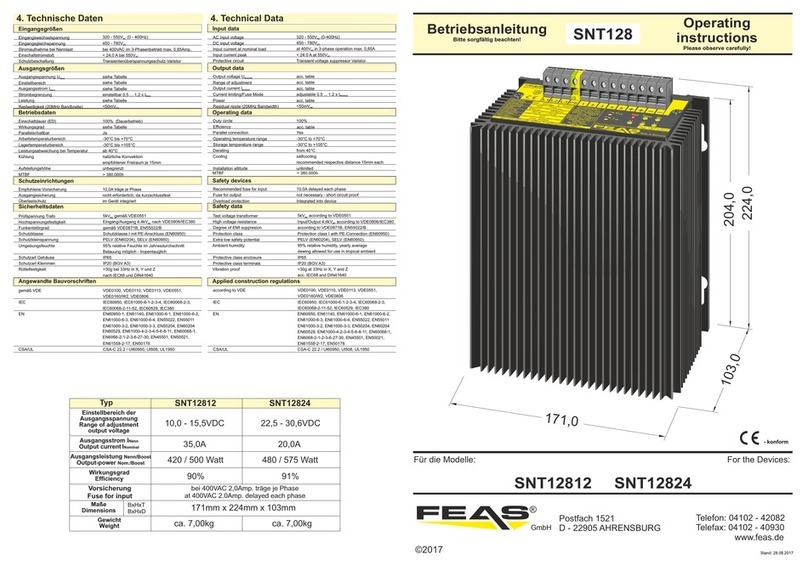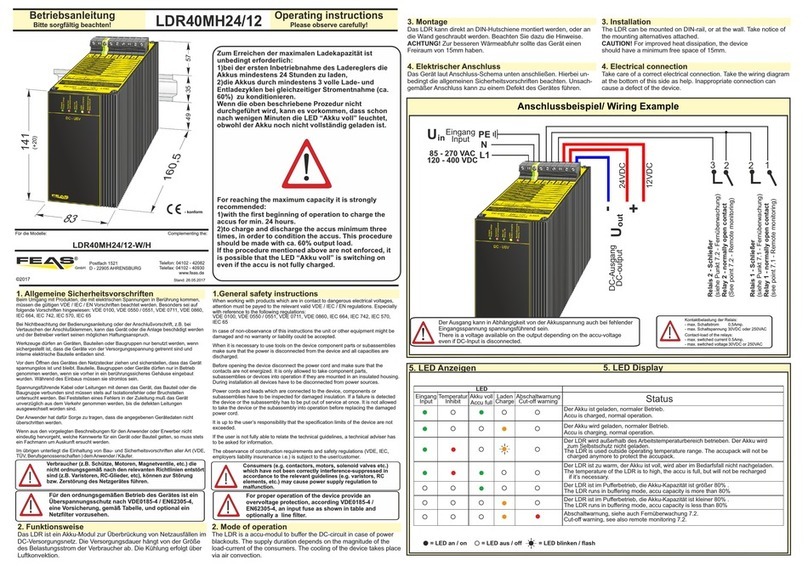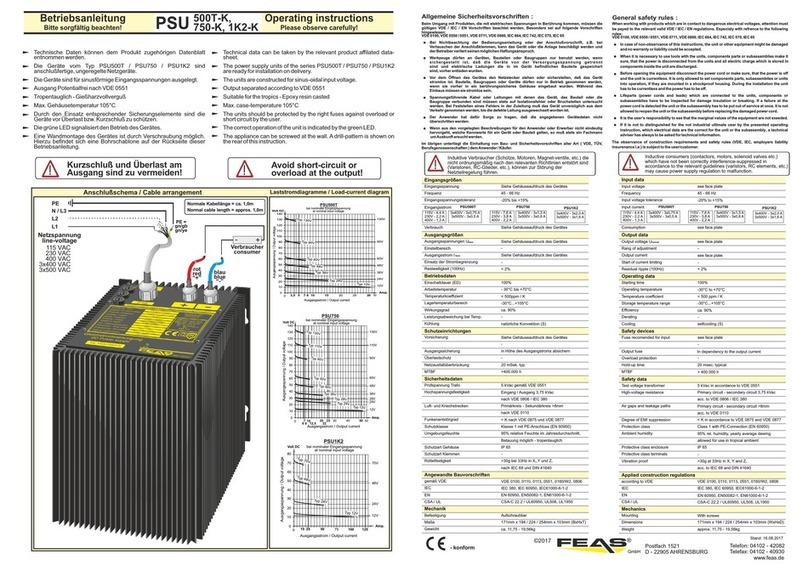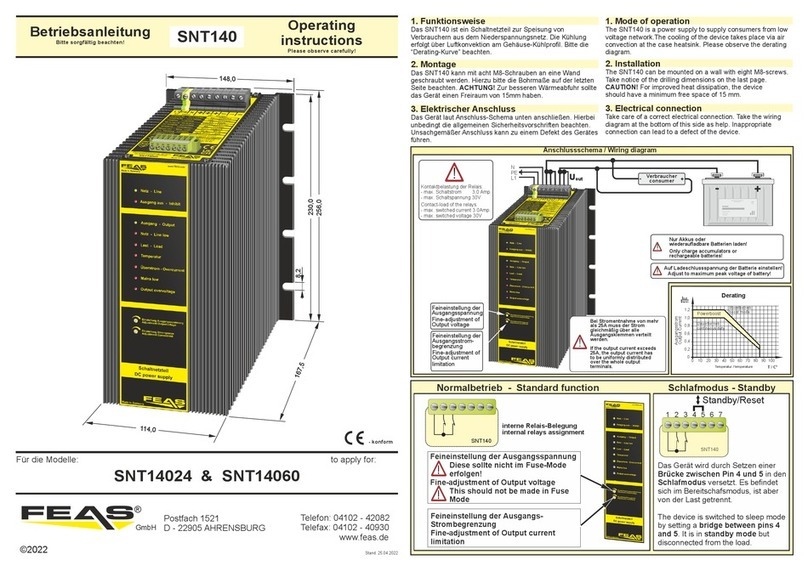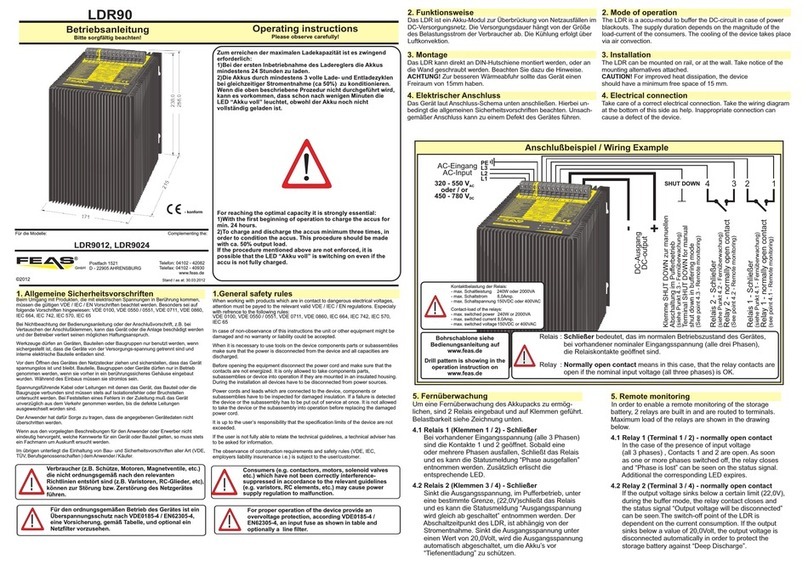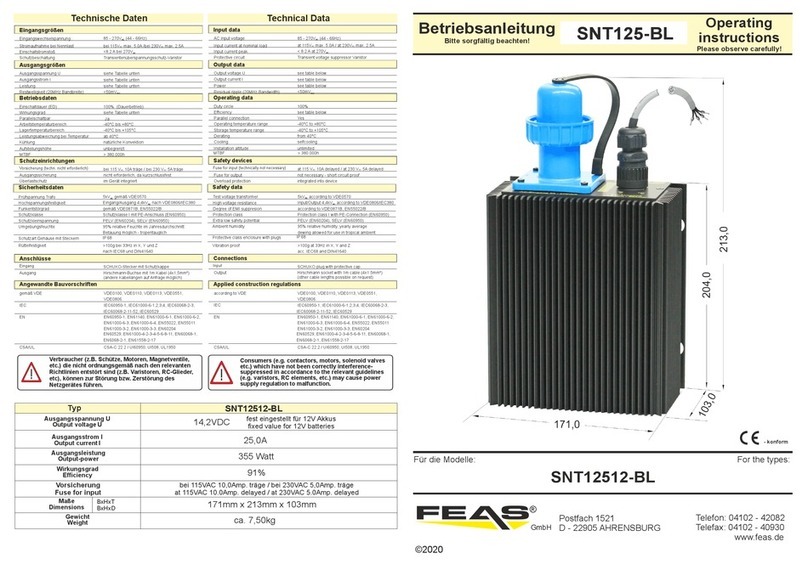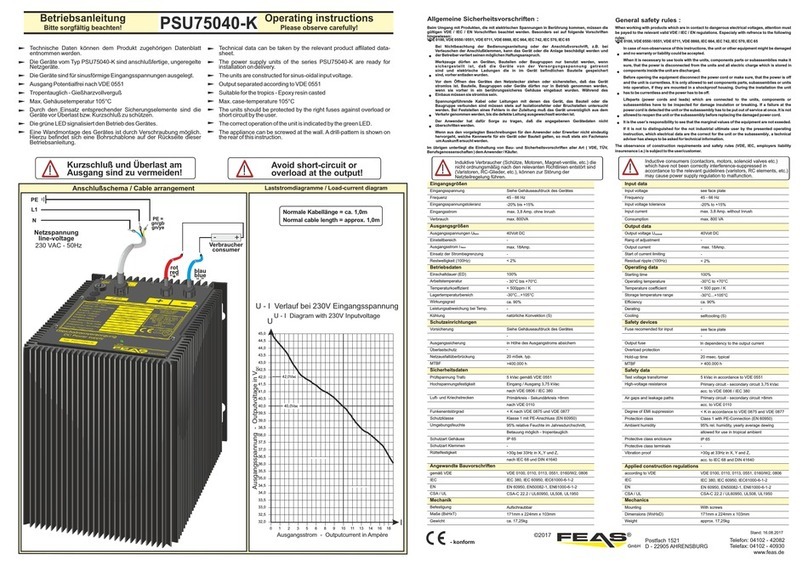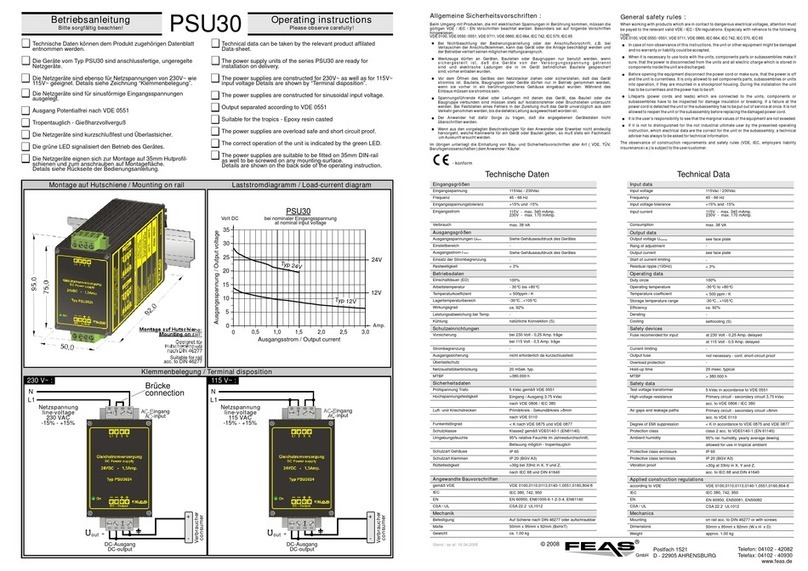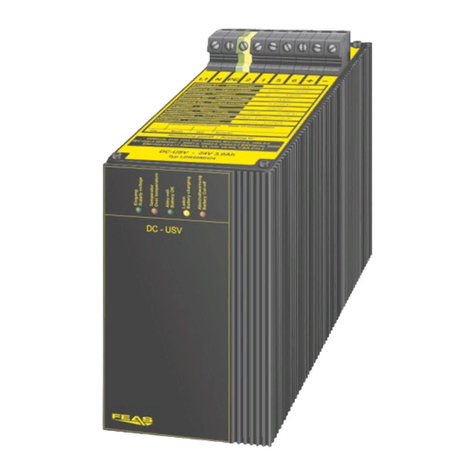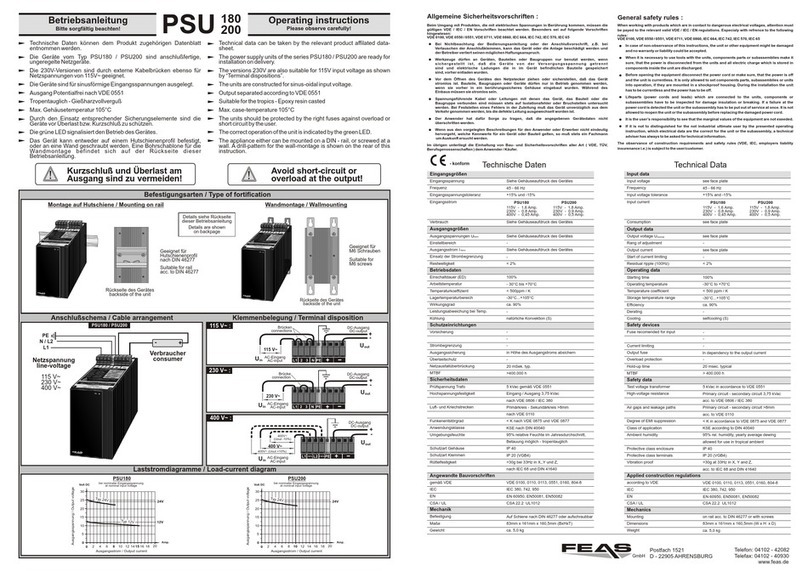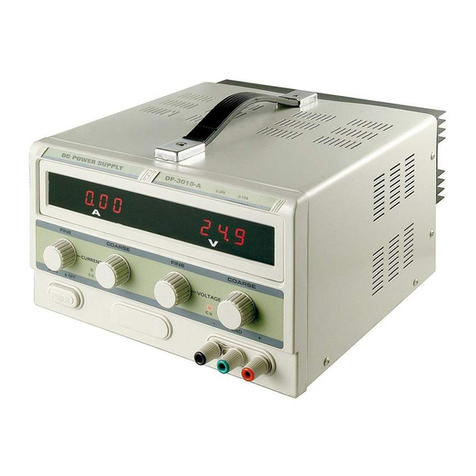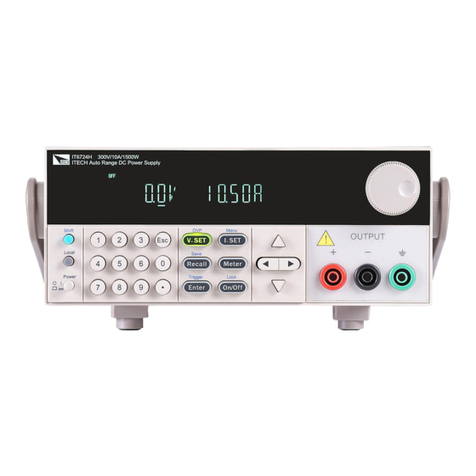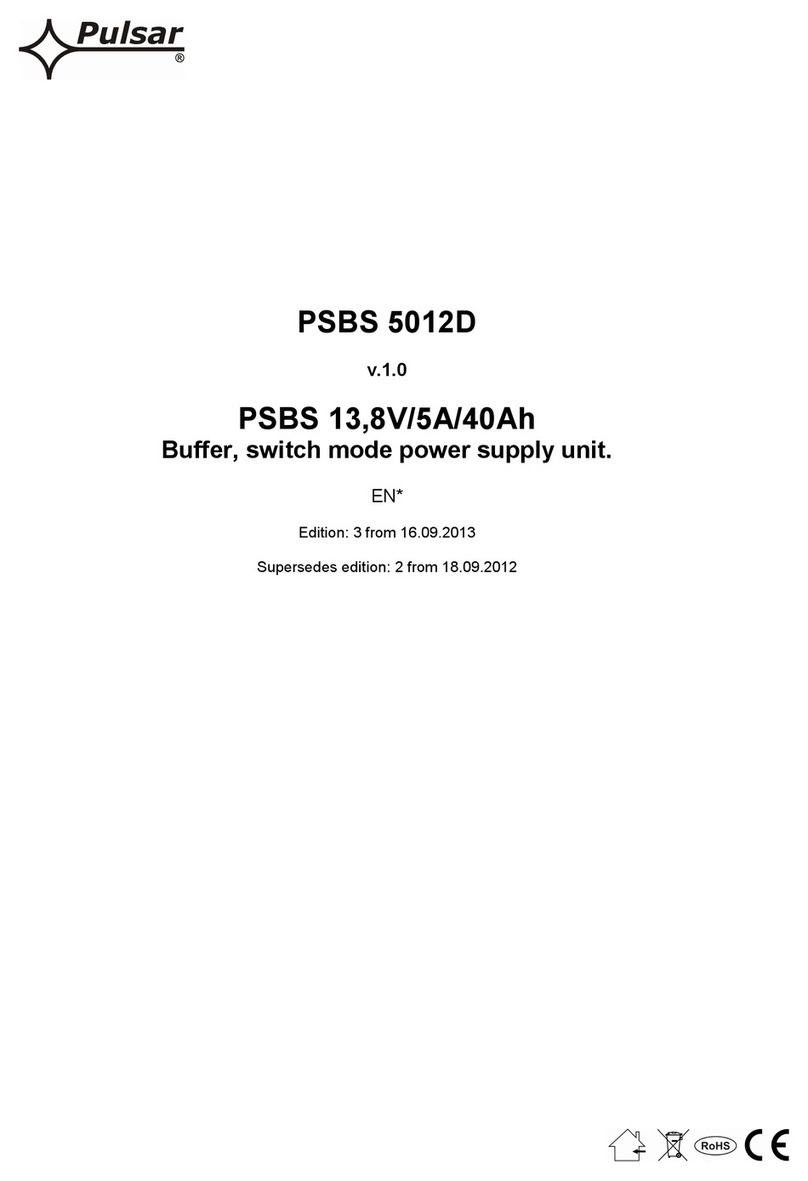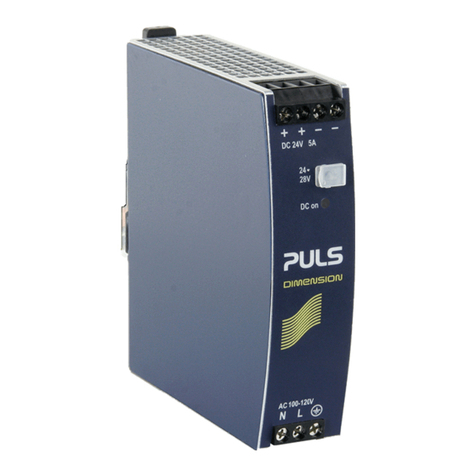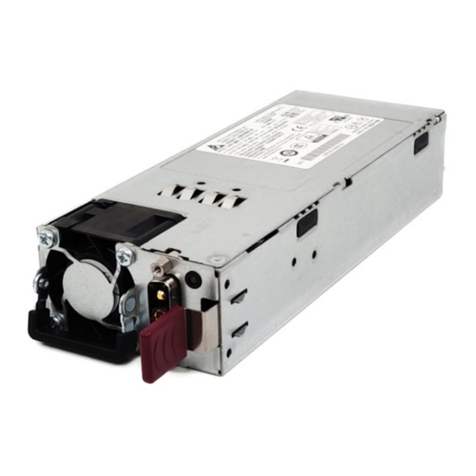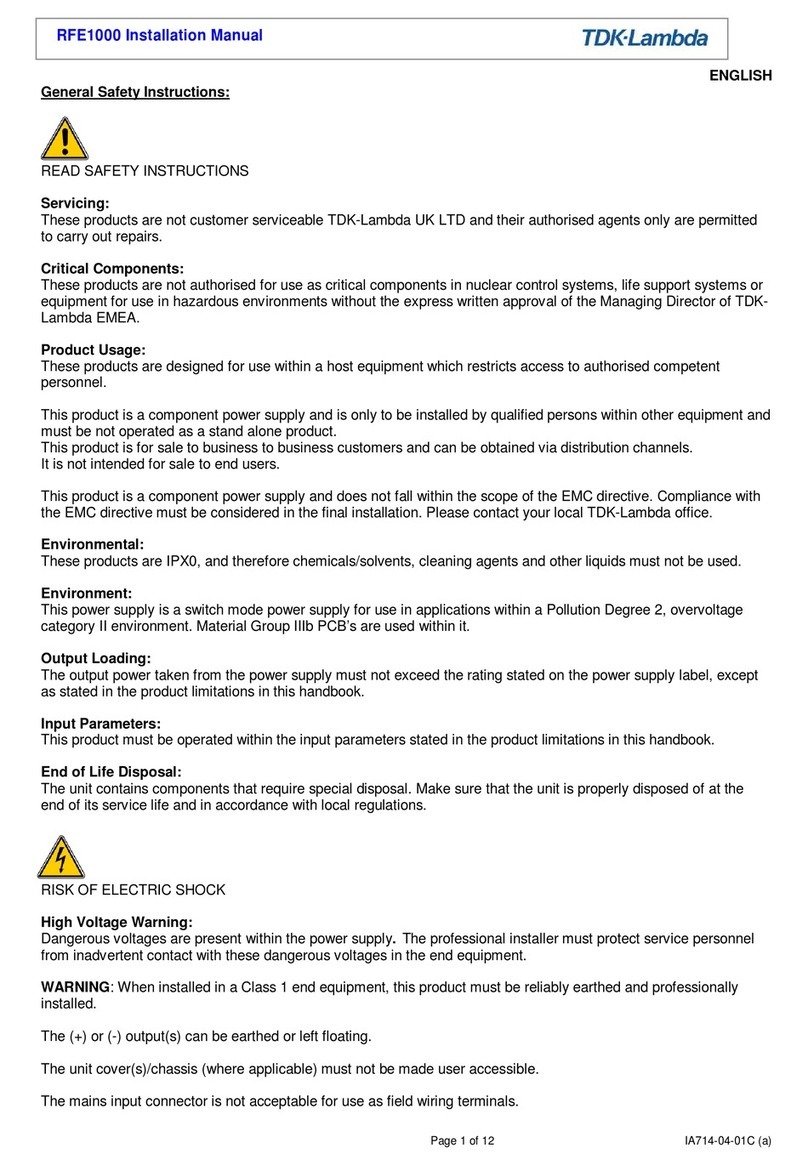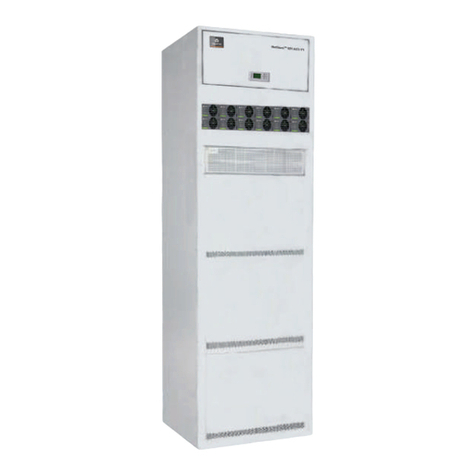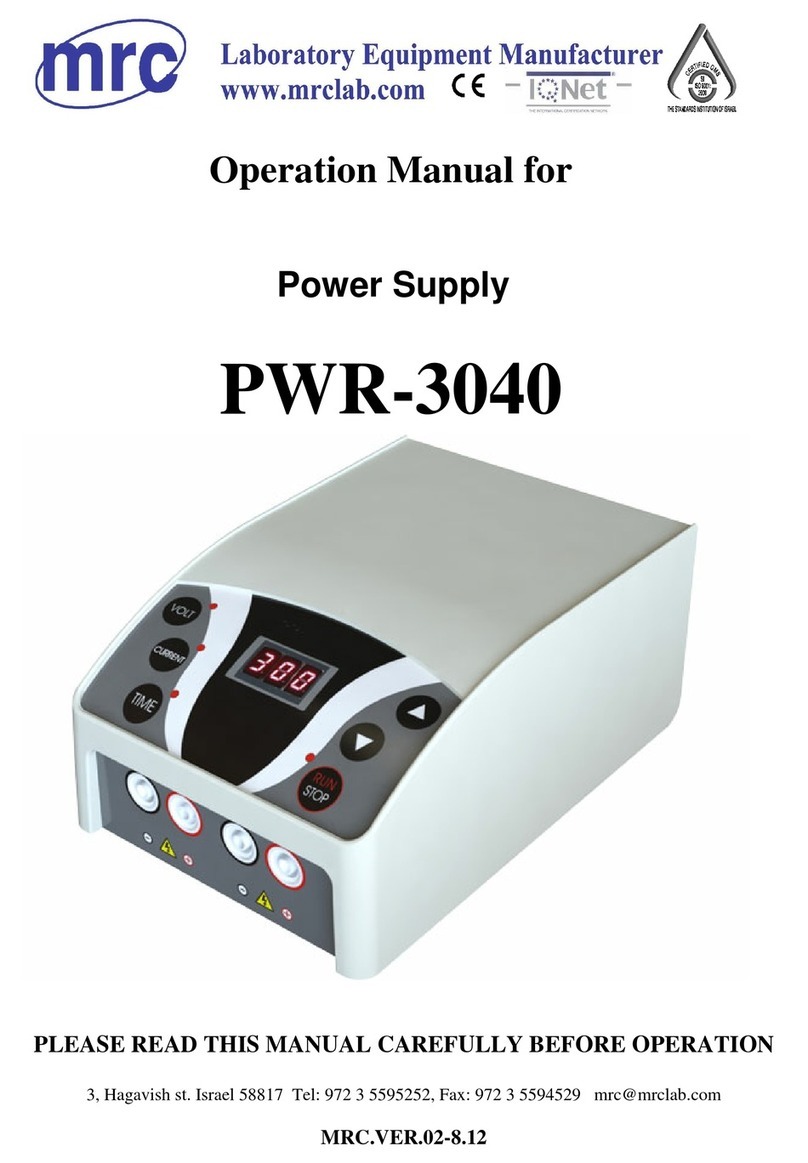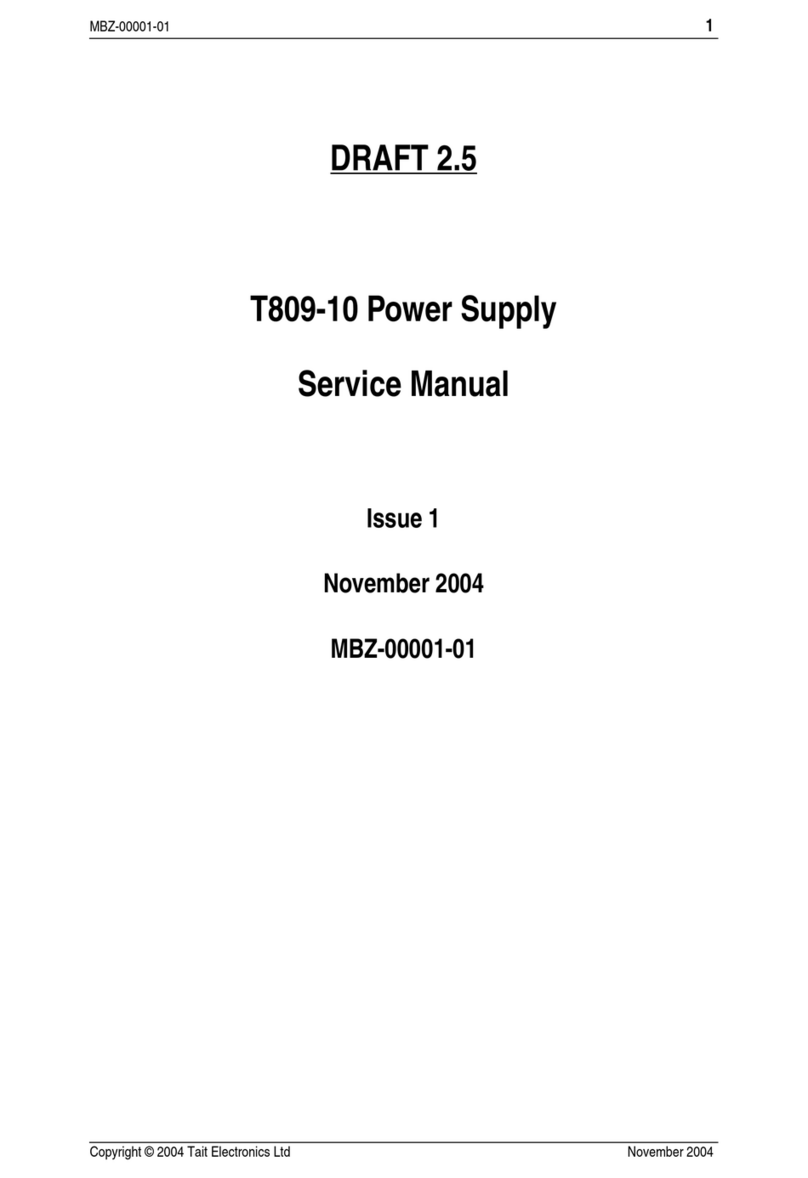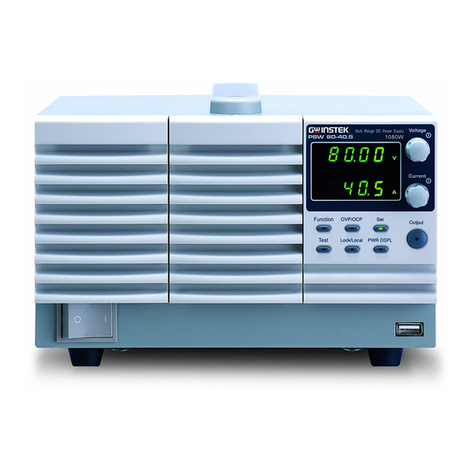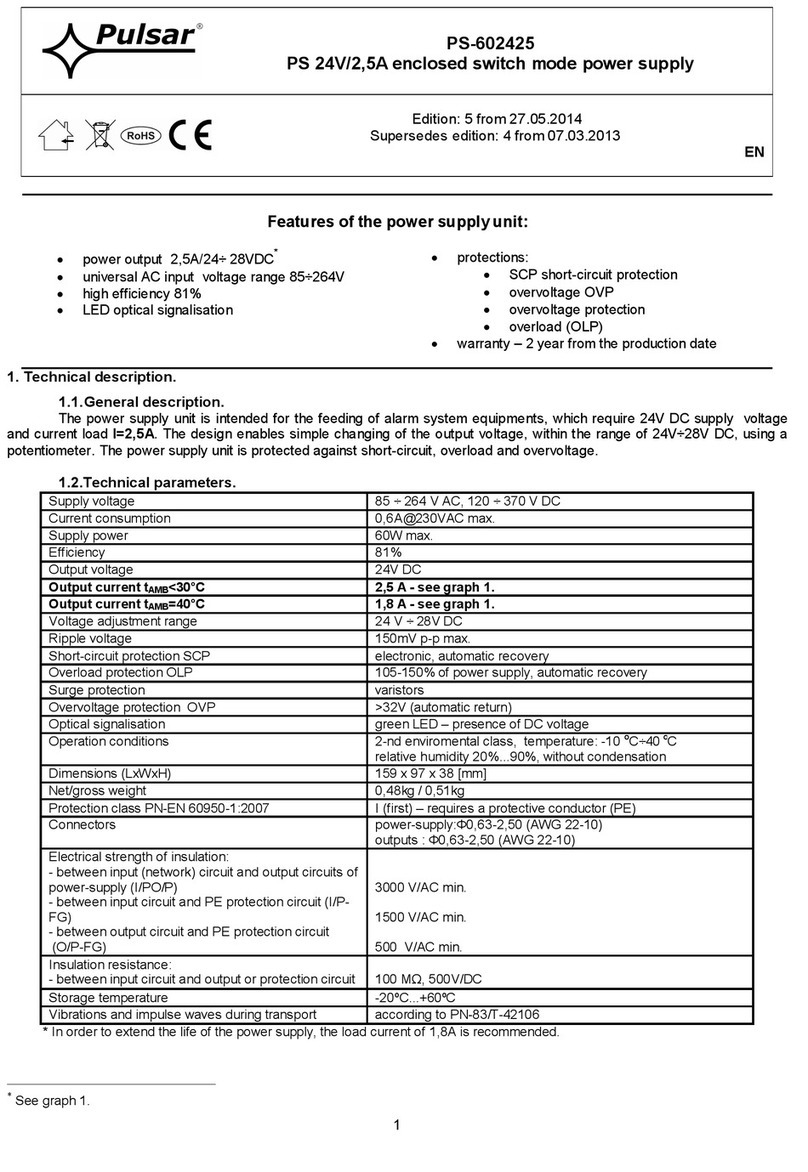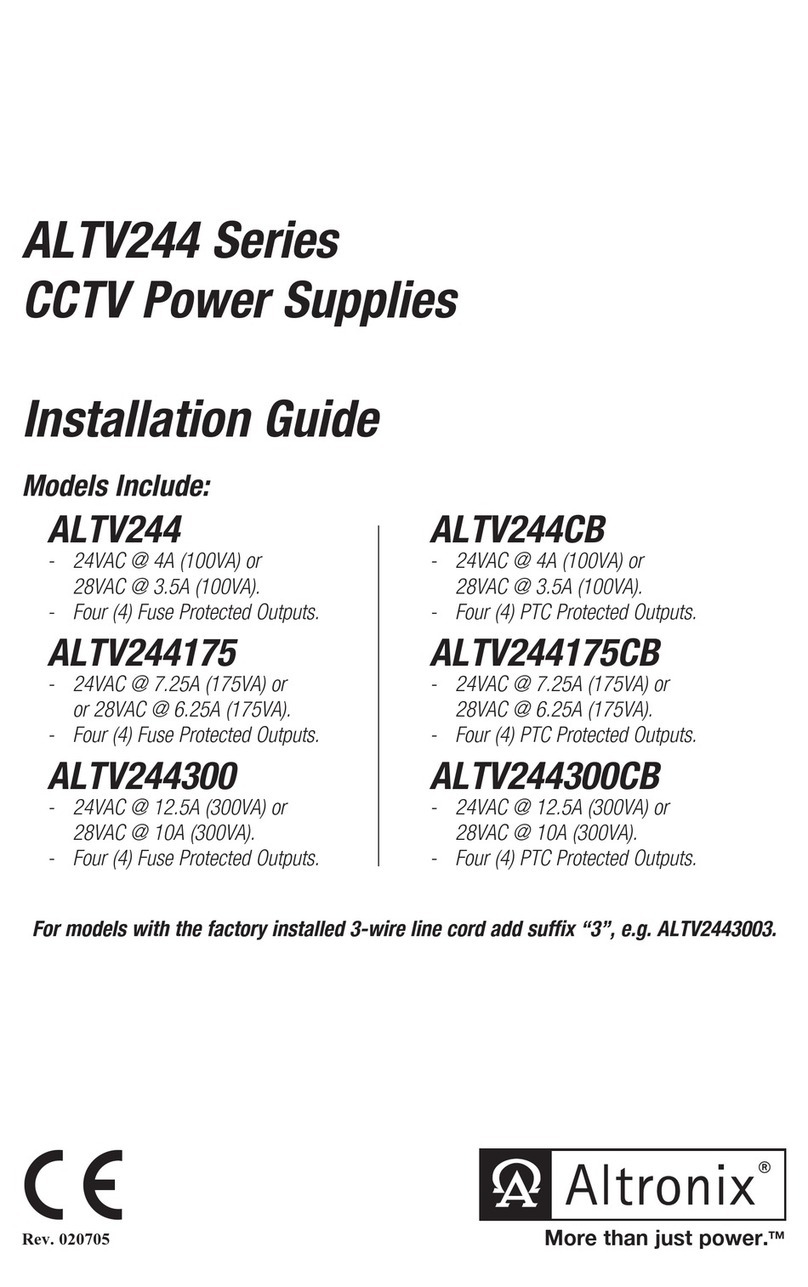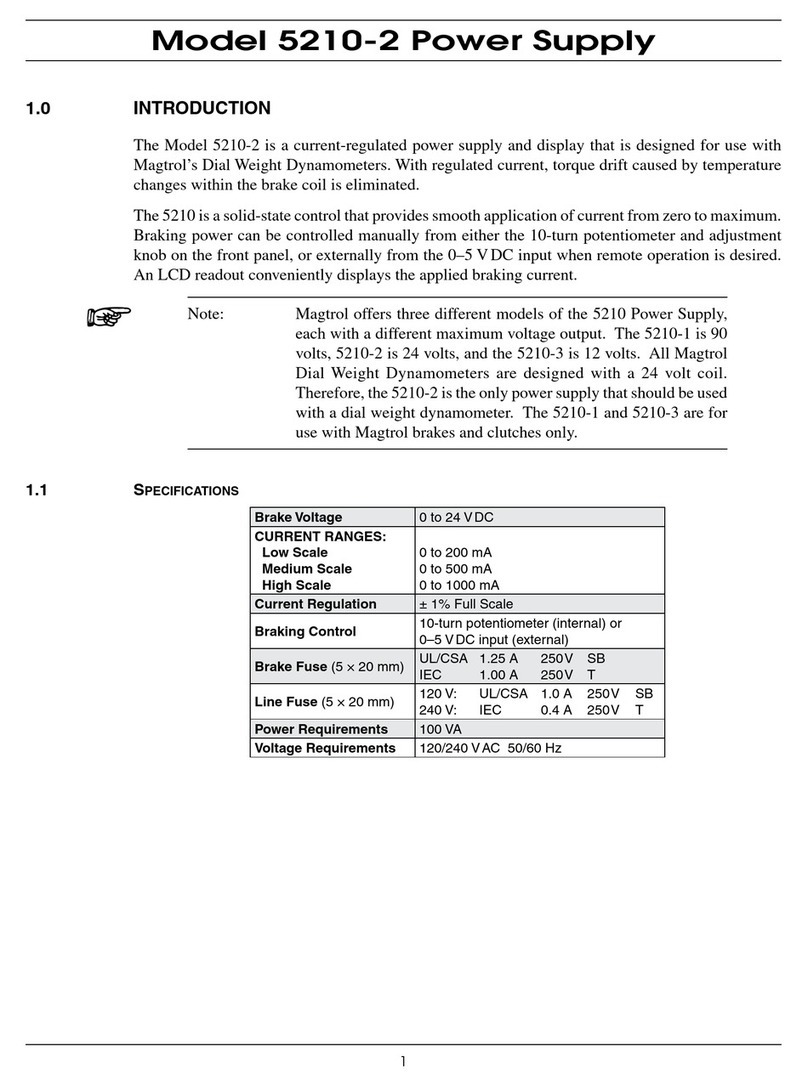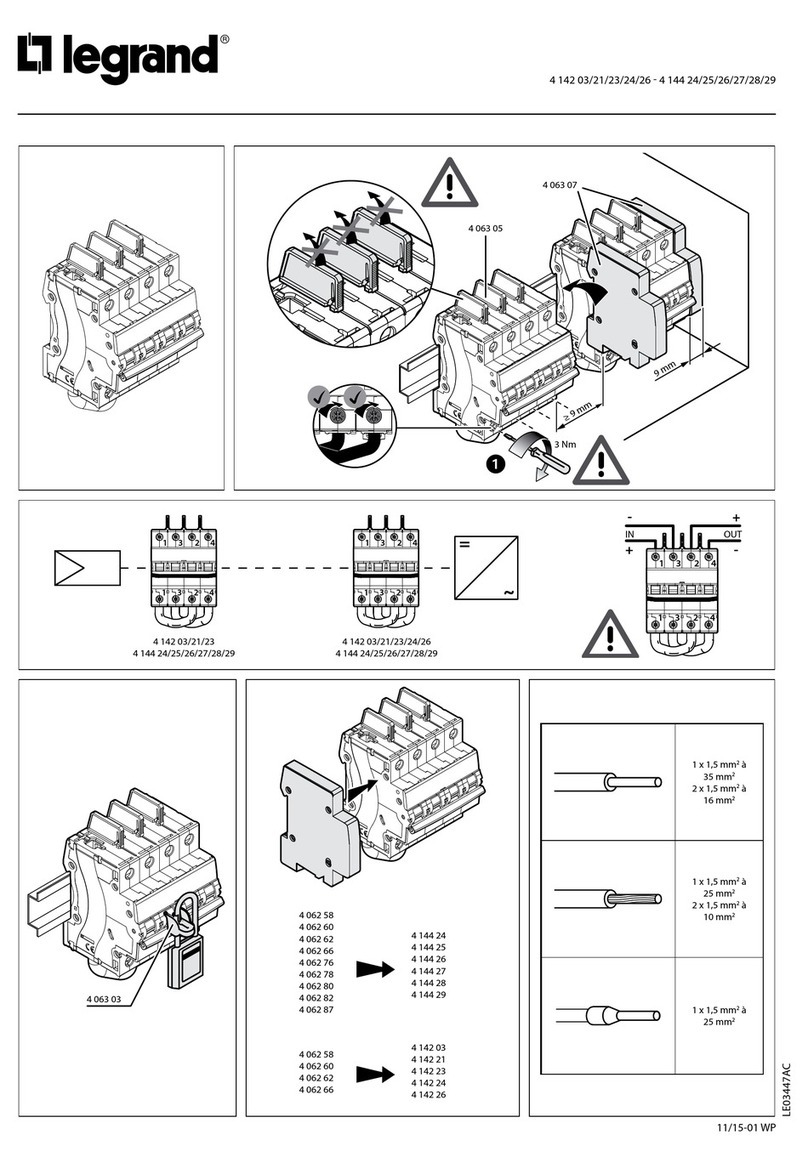FEAS LDR8024-RS User manual

© 2021
Postfach 1521
D - 22905 Ahrensburg
Telefon: +49 4102 42082
Fax: +49 4102 40930
E-Mail: [email protected]
Internet: www.feas.de
Betriebsanleitung
Bitte sorgfältig beachten!
Operating instructions
Please observe carefully! Bitte sorgfältig beachten! Please observe carefully!
- konform
- LDR8024-RS -
Für die Modelle: Complementing the:
Verbraucher (z.B. Schütze, Motoren, Magnetventile, etc.) die
nicht ordnungsgemäß nach den relevanten Richtlinien
entstört sind (z.B. Varistoren, RC-Glieder, etc), können zur
Störung bzw. Zerstörung des Netzgerätes führen.
Die RS-232-Schnittstelle ist (anders als RS-485)
nicht von der DC-Seite potentialgetrennt.
Bei Anschluss z.B. an Rechner muss gegebenenfalls für
Potentialtrennung gesorgt werden!
Für den ordnungsgemäßen Betrieb des Gerätes ist ein
Überspannungsschutz nach VDE0185-4 / EN62305-4,
eine Vorsicherung, gemäß Tabelle, und optional ein
Netzfilter vorzusehen.
1. Allgemeine Sicherheitsvorschriften
Beim Umgang mit Produkten, die mit elektrischen Spannungen in
Berührung kommen, müssen die gültigen VDE / IEC / EN Vorschriften
beachtet werden. Besonders sei auf folgende Vorschriften hingewiesen:
VDE 0100, VDE 0550 / 0551, VDE 0711, VDE 0860, IEC 664, IEC 742,
IEC 570, IEC 65
Bei Nichtbeachtung der Bedienungsanleitung oder der
Anschlussvorschrift, z.B. bei Vertauschen der Anschlussklemmen, kann
das Gerät oder die Anlage beschädigt werden und der Betreiber verliert
seinen möglichen Haftungsanspruch.
Werkzeuge dürfen an Geräten, Bauteilen oder Baugruppen nur benutzt
werden, wenn sichergestellt ist, dass die Geräte von der
Versorgungsspannung getrennt sind und interne elektrische Bauteile
entladen bzw Akkus ausgebaut sind.
Vor dem Öffnen des Gerätes den Netzstecker ziehen und sicherstellen,
dass das Gerät spannungslos ist und bleibt. Bauteile, Baugruppen oder
Geräte dürfen nur in Betrieb genommen werden, wenn sie vorher in ein
berührungssicheres Gehäuse eingebaut wurden. Während des Einbaus
müssen sie stromlos sein.
Spannungsführende Kabel oder Leitungen mit denen das Gerät, das
Bauteil oder die Baugruppe verbunden sind müssen stets auf
Isolationsfehler oder Bruchstellen untersucht werden. Bei Feststellen
eines Fehlers in der Zuleitung muß das Gerät unverzüglich aus dem
Verkehr genommen werden, bis die defekten Leitungen ausgewechselt
worden sind.
Der Anwender hat dafür Sorge zu tragen, dass die angegebenen
Gerätedaten nicht überschritten werden.
Wenn aus den vorgelegten Beschreibungen für den Anwender oder
Erwerber nicht eindeutig hervorgeht, welche Kennwerte für ein Gerät
oder Bauteil gelten, so muss stets ein Fachmann um Auskunft ersucht
werden.
Im übrigen unterliegt die Einhaltung von Bau- und Sicherheitsvorschriften
aller Art (VDE, TÜV, Berufsgenossenschaften ) dem Anwender / Käufer.
1.General safety instructions
When working with products which are in contact to dangerous electrical
voltages, attention must be payed to the relevant valid VDE / IEC / EN
regulations. Especially with reference to the following regulations:
VDE 0100, VDE 0550 / 0551, VDE 0711, VDE 0860, IEC 664, IEC 742,
IEC 570, IEC 65
In case of non-observance of this instructions the unit or other equipment
might be damaged and no warranty or liability could be accepted.
When it is necessary to use tools on the device component parts or
subassemblies make sure that the power is disconnected from the device
and all capacities are discharged.
Before opening the device disconnect the power cord and make sure that
the contacts are not energized. It is only allowed to take component
parts, subassemblies or devices into operation if they are mounted in an
insulated housing. During installation all devices have to be disconnected
from power sources.
Power cords and leads which are connected to the device, components
or subassemblies have to be inspected for damaged insulation. If a
failure is detected the device or the subassembly has to be put out of
service at once. It is not allowed to take the device or the subassembly
into operation before replacing the damaged power cord.
It is up to the user’s responsibility that the specification limits of the
device are not exceeded.
If the user is not fully able to relate the technical guidelines, a technical
adviser has to be asked for information.
The observance of construction requirements and safety regulations
(VDE, IEC, employers liability insurenance i.e.) is subject to the
user/customer.
171
196
215
Stand / as at: 17.11.2021
Eingangsspannung - Input voltage
Kapazität - Capacity
85V ...270V / 120V ....400V
AC AC DC DC
20,0 - 27,6 VDC
10A (Boost max.14A)
Ausgangsstrom - Output current
Pufferzeit - Hold-up-time max. 10A/24V 40min
7Ah
Ausgangsspannung
folgt der Akkuspannung (U )
Puffer
Outputvoltage
follows the accu voltage (U )
buffer
Aufgrund der internen Transienten-Schutzschaltung
sollte die Isolationsprüfung Ihrer Anlage nicht mit
unserem Gerät erfolgen.
Due to the internal transient protection circuit, the insulation
test of your system should not be carried out with our device.
!
device
e.g. SNT230
Grobschutz
Surge protective
devices
Typ1
>1300V
Mittelschutz
Surge protective
devices
Typ2
>600V
Feinschutz
Surge protective
devices
Typ3
<600V
Netzfilter
linefilter
e.g.
FEAS NFK
VDE0185-4 / EN62305-4
Überspannungs- und Transientenschutz
Overvoltage and Transientprotection
Blitz- und Transientenschutz
lightning and overvoltage protection
EMV Schutz
EMC protection
-
RS232 interface (unlike the RS485 interface) is
not electrically isolated from the DC side.
When connecting e.g. to a computer potential separation
must be ensured!
Consumers (e.g. contactors, motors, solenoid valves etc.)
which have not been correctly interference-suppressed in
accordance to the relevant guidelines (e.g. varistors, RC
elements, etc.) may cause power supply regulation to
malfunction.
For proper operation of the device provide an
overvoltage protection, according VDE0185-4 /
EN62305-4, an input fuse as shown in table and
optionally a line filter.
Die „Ergänzende Anleitung zum
Betrieb des LDR8024-RS über die
RS-Schnittstelle“ finden Sie im
Downloadbereich des LDR8024-RS
unter feas.de).
!
The "Supplementary instructions
for operating the LDR8024-RS via
the RS interface" can be found in
the download area of the LDR8024-
RS at feas.de).
!

2. Funktionsweise
Das LDR ist ein gepuffertes Netzteil zur Überbrückung von
Netzausfällen im DC-Versorgungsnetz. Die Versorgungsdauer
hängt von der Größe des Belastungsstroms der Verbraucher ab.
Die Kühlung erfolgt über Luftkonvektion.
3. Montage
Das LDR kann direkt an die Wand oder ein Montageblech
geschraubt werden. Beachten Sie dazu die Hinweise.
ACHTUNG! Zur besseren Wärmeabfuhr sollte das Gerät einen
Freiraum von min. 15mm haben.
3. Installation
The LDR can be mounted at the wall or any mounting sheet. Take
notice of the mounting alternatives attached.
CAUTION! For improved heat dissipation, the device
should have a minimum free space of 15mm.
4. Elektrischer Anschluss
Das Gerät laut Anschluss-Schema unten anschließen. Hierbei un-
bedingt die allgemeinen Sicherheitsvorschriften beachten. Unsach-
gemäßer Anschluss kann zu einem Defekt des Gerätes führen.
Nach dem Zuschalten der Spannungsversorgung vergehen ca. 15
Sekunden, bis der Ausgang freigegeben wird.
4. Electrical connection
Take care of a correct electrical connection. Take the wiring
diagram at the bottom of this side as help. Inappropriate connection
can cause a defect of the device.
After switching on the power supply, approx. 15 seconds pass until
the output is enabled.
2. Mode of operation
The LDR is a buffered power supply unit for bridging mains failures
in the DC supply network. The supply duration depends on the
magnitude of the load-current of the consumers. The cooling of the
device is achieved via air convection.
5. RS-232/RS-485 interface
The unit can be connected to a computer via the D-Sub-9 socket
of the LDR80-RS. Data can then be exchanged with the PC via the
RS-232 or RS-485 interface, allowing the LDR to be monitored
and operated.
For configuration and operation, see "Supplementary instructions
for operating the LDR8024 via the RS interface"
(see download area of the LDR8024-RS at feas.com).
5. RS-232/RS-485-Anschluss
Das Gerät kann über die D-Sub-9 Buchse des LDR80-RS an
einen Computer angeschlossen werden. Über die RS-232- oder
RS-485-Schnittstelle können dann Daten mit dem PC
ausgetauscht, so dass das LDR überwacht und bedient werden
kann.
Konfigruation und Betrieb finden sie in „Ergänzende Anleitung
zum Betrieb des LDR8024 über die RS-Schnittstelle“
(zu finden im Downloadbereich des LDR8024-RS unter feas.de).
Eingang
Input
Uin
Uout
DC-Ausgang
DC-output
85 - 270 VAC
oder / or
120 - 400 VDC
Anschlussbeispiel/ Wiring Example
+
-
L1
N
1
2
PE
3
4
7. Betriebshinweise / Schutzschaltungen
a) Thermischer Akku-Schutz
Um die eingebauten Akkus vor zu starker Erwärmung zu schützen,
ist das LDR mit einem thermischen Schutz für die Akkus
ausgerüstet.
Übersteigt die Akkutemperatur einen kritischen Wert, können die
Akkus nicht mehr geladen bzw. nachgeladen werden.
In diesem Fall ist kein Pufferbetrieb mehr gewährleistet. Befindet
sich das Gerät im Pufferbetrieb, so wird die Last getrennt.
Aus diesem Grunde bitte für ausreichende Kühlung sorgen!
b) Schutz vor Tiefentladung
Sinkt die Akkuspannung im Pufferbetrieb unter einen kritischen
Wert von ca. 19,0V (24V-Version), wird die Ausgangsspannung
automatisch abgeschaltet, um die Akkus vor “Tiefenentladung”
zu schützen. Im RS-232/RS-485-Betrieb erfolgt eine Meldung an
den Rechner. Danach schaltet sich das LDR komplett ab, bis
die Eingangsspannung wieder vorliegt.
c) Schutz vor Überlast / Kurzschluss
Bei Überlast oder Kurzschluss trennt das Gerät die Last und
schaltet diese anschließend automatisch wieder zu. Die Auszeit für
die Erholung des Gerätes verlängert sich mit der Anzahl dieser
Ereignisse.
Ab einer gewissen Anzahl dieser Ereignisse bzw. bei
Dauerkurzschluss:
- im Netzbetrieb, wird die Last dauerhaft getrennt (siehe LEDs).
Eine erneute Lastzuschaltung muss manuell erfolgen, durch
zweimaliges Verbinden und Trennen der Kontakte 4-3 für jeweils
5 Sekunden.
- im Pufferbetrieb schaltet sich das Gerät komplett ab.
Eine Reaktivierung erfolgt durch Anlegen der Netzspannung.
d) Fuse Mode
Beim Betrieb über die RS-Schnittstelle kann Fuse-Mode aktiviert
werden. Wenn die interne Sicherung dann ausgelöst wird, schaltet
das Gerät die Last dauerhaft ab.
Um das Gerät zu reaktivieren, muss das Gerät von der
Hauptstromversorgung getrennt werden.
Nach ca. 1 Minute kann das Gerät durch das Zuschalten der
Hauptstromversorgung wieder reaktiviert werden.
7. Operation notes / Protective shutdowns
a) Thermal battery protection
In order to protect the built-in storage batteries from inadmissible
heating, the LDR is equipped with a thermal protection for the
accumulators.
If the battery temperature exceeds a critical value, the batteries can
no longer be charged or recharged. In this case, buffer operation is
not guaranteed. In case of indadmissable heating during buffering
mode, the DC output will be shuted down.
For this reason please provide for sufficient cooling!
b) Protection against deep discharge of the battery
If the voltage of the accumulator decreases below a critical value
of about 19,0V (24V Version) the output voltage will be
disconnected automatically in order to protect the storage battery
against “Deep Discharge”. Via the RS interface the LDR sends a
message to the computer. The LDR then switches off
completely until the input voltage is present again.
c) Protection against overload / short circuit
In the event of an overload or short circuit, the unit disconnects the
load and then automatically reconnects it. The time-out for the unit
to recover increases with the number of these events.
After a certain number of these events or in the case of a
continuous short circuit:
- in mains operation, the load is permanently disconnected
(see LEDs).
The load must be switched on again manually by connecting and
disconnecting terminals 4-3 twice for 5 seconds each.
- In buffer mode, the unit switches off completely.
Reactivation takes place by applying the mains voltage.
d) Fusemode
By using the RS interface, fuse mode can be activated. If the
internal fuse is then triggered, the unit immediately switches off
the load durably. In order to reactivate the device, the device
must be disconnected from the main power supply.
After about 1 minute the device can be reactivated by switching
on the main power supply.
6.1 Abschaltung Ausgang
Eine manuelle Lasttrennung ist über die Verbindung der
Klemmen 1-2 am LDR möglich.
Auch über die RS-Schnittstelle kann die Ausgangsspannung
freigegeben oder getrennt werden.
6.1 DC off
The load can be manually disconnected ing the by connect
terminals 1-2 of the LDR.
Also via the RS interface the DC output can be switched on or off.
6.2 Vollständiges Abschalten des LDR
Zum vollständigen Abschalten das LDR vom Netz trennen und
warten, bis das LDR den Pufferbetrieb aufgenommen hat.
Danach die Klemmen 3 und 4 für ca. 15 Sekunden verbinden.
Nach ca. 30 Sekunden wird das Gerät vollständig abgeschaltet
und erst durch Einschalten der Eingangsspannung wieder
aktiviert.
Der Betreiber hat dafür zu sorgen, dass während des
Abschaltvorgangs keine Netz- bzw. Eingangsspannung
zugeschaltet wird.
6.2 Complete shutting down of the LDR
To shut down completely, disconnect the LDR from mains
supply and wait until LDR switches to buffering mode.
Then connect terminals 3 and 4 for approx. 15 seconds.
After about 30 seconds the unit is completely switched off and
will only be reactivated when the input voltage is switched on.
The operator must ensure that no mains or input voltage is
switched on during the shutdown process.
6. Abschaltfunktionen 6. Shutdown Functions
Zum Erreichen der maximalen Ladekapazität bitte
beachten:
1) Bei der ersten Inbetriebnahme des Ladereglers
die Akkus mindestens 24 Stunden laden!
2) Die Akkus durch mindestens 3 volle Lade- und
Entladezyklen bei gleichzeitiger Stromentnahme
(ca. 60%) konditionieren!
Ansonsten kann es vorkommen, dass schon nach wenigen
Minuten die LED “Akku voll” leuchtet, obwohl der Akku
noch nicht vollständig geladen ist.
For reaching the maximum capacity it is strongly
recommended:
1) Charge the batteries for at least 24 hours
when using the charge controller for the very first time!
2) Condition the batteries by at least 3 full charge and
discharge cycles with simultaneous current drain
(approx. 60%)!
Otherwise, the "Akku voll" LED may light up after just a
few minutes, even though the battery is not yet fully
charged.
!
Akkuvorbereitung Preparation Battery
Bei längerer Lagerung wird empfohlen, die Akkus
elektrisch vom Gerät zu trennen und mindestens alle 6
Monate zu laden.
In case of prolonged storage, it is recommended to
disconnect the batteries electrically from the device
and to charge them at least every 6 months.
Klemme 1-2
Manuelle Lasttrennung (siehe 6.1)
Klemme 3-4
vollständiges Abschalten des LDR
nach Netztrennung + Pufferbetrieb (siehe 6.2)
Batterieanzeige-/Gerätereset
nach Akkutausch (siehe 10, Schritt 3)
Reaktivierung (siehe 7c)
Terminal 1-2
Manual load disconnection (see 6.1)
Terminal 3-4
complete switch-off of the LDR
after mains disconnection + buffer mode (see 6.2)
Battery status indicator reset / device reset
after battery exchange (see 10, step 3)
Reactivation (see 7c)
Klemmen /
Terminals
Achtung! Der Ausgang kann in Abhängigkeit von
der Akkuspannung auch bei fehlender
Eingangsspannung spannungsführend sein.
Attention! There is a voltage available on the
output depending on the accu-voltage even if DC-
Input is disconnected.

9. Mainenance9. Wartung
10. Batteriewechsel
Ein defekter Akku wird durch LEDs angezeigt (siehe Kapitel 8)
Das Gerät kann auch ohne Akkus als Netzgerät betrieben
werden. Dazu müssen die Akkus aus dem Gerät entfernt
werden!
Der Akkutausch sollte bei einer Temperatur von ca. 20°C-25°C
erfolgen, da sonst am Rechner falsche Werte angezeigt
werden können.
Schritt 1: Vollständiges Abschalten des Gerätes
- Dazu das LDR vom Netz trennen und warten, bis das LDR den
Pufferbetrieb aufgenommen hat (siehe Kapitel LED Anzeigen)
- Klemmen 3 und 4 verbinden.
Somit ist das Gerät vollständig abgeschaltet.
Schritt 2: Akkuausbau
- Gerät auf den Kopf stellen.
- Zum Öffnen der Bodenplatte die 7 Inbusschrauben (M4) lösen.
- Akkus herausnehmen und die Kabel von den Kontakten abziehen.
Achtung! Zur Vermeidung eines Kurzschlusses die Akku-
Anschlusskabel unbedingt voneinander isolieren!
Schritt 3: Gerät / Batteriezustandsanzeige zurücksetzen
(Klemmen 3-4 sind dabei verbunden)
- Das Gerät an die Netzspannung anschließen und warten, bis alle
LEDs (außer „Laden“) blinken. Danach nochmals etwa 3 Minuten
warten. (Im RS-Betrieb erscheint am Terminalprogramm
„EPROM RESET PROGRAM FINISHED.“)
- Das LDR von der Netzspannung wieder trennen.
- Etwa 1 Minute ohne Strom lassen, bis alle LEDs ausgehen
(Restentladung aller Kondensatoren).
- Verbindung zwischen Klemmen 3 und 4 lösen.
Schritt 4: Neue Akkus einbauen
- Neue Akkus an die Kabel anschließen.
Unbedingt auf korrekte Polarität achten! Rotes Achtung!
Kabel zum Plus-Pol, blaues Kabel zum Minus-Pol des Akkus.
Beim Vertauschen oder Berühren der Klemmen mit falscher
Polarität kann das Gerät zerstört werden!
- Akkus in den Batterieraum schieben.
- Bodenplatte wieder aufschrauben.
Die alten Akkus ordnungsgemäß und umweltgerecht entsorgen!
Die Lebensdauer der Akkus hängt laut Akku-Hersteller von der
Anzahl der Lade- und Entladezyklen, des Entladestroms und der
Betriebstemperatur ab.
10. Battery replacement
A defective battery is indicated by LEDs (see chapter 8).
The unit can also be operated as a mains unit without
batteries. This requires the batteries to be removed from the
device!
The battery should be replaced at a temperature of approx.
20°C-25°C, otherwise incorrect values may be indicated at the
computer.
Step 1: Switch off the device completely
- disconnect the LDR from the mains and wait until the LDR has
started buffer operation (see chapter LED displays).
- Connect terminals 3 and 4.
The unit is now completely switched off.
Step 2: Battery removal
- Turn the unit upside down.
- To open the base plate, loosen the 7 Allen screws (M4).
- Remove the batteries and disconnect the cables from the
contacts.
To avoid a short circuit, insulate the battery Caution!
connection cables from each other!
Step 3: Reset the device / battery status indicator
(while 3-4 are connected)
- Connect the unit to the mains voltage and wait until all LEDs
(except "charging") flash. Then wait again for about 3 minutes.
(In RS mode, the terminal program displays
"EPROM RESET PROGRAM FINISHED.")
- Disconnect the LDR from the mains voltage again.
- Leave it without power for about 1 minute until all LEDs go out
(residual discharge of all capacitors).
- Disconnect the connection between terminals 3 and 4.
Step 4: Install new batteries
- Connect new batteries to the cables.
Note polarity! Red cable to the positive pole, blue cable to
the negative pole of the battery. The device can be destroyed
if the terminals are reversed or touched with the wrong
polarity!
- Slide the batteries into the battery compartment.
- Screw the base plate back on.
Dispose of the old batteries properly and in an environmentally
friendly manner!
According to the battery manufacturer, the service life of the
batteries depends on the number of charge and discharge cycles,
the discharge current and the operating temperature.
Eine Verpolung der Akkus beim Einsetzen führt unweigerlich
zur Zerstörung des Gerätes, ist nicht reparabel und führt
zum Erlöschen der Gewährleitungsansprüche.
Reverse polarity of battery causes the damage of the device
and is not repairable. This leads to termination of warranty.
Batteriewechsel / Battery replacement
Accu 2
Accu 1
+
-
+
-
Remove here the
screws M4 with
Inbus-key(SW2,5)!
!
!
LED schnelles blinken / LED flashing fast
Laden /
Battery
charging
Eingang /
Supply Voltage
Temperatur /
Over-
temperature
Akku voll /
Battery OK
Abschalt-
warnung /
Battery Cutt-off
Daten-
austausch /
Data transfer
DC - Ausgang
Voltage output
Erreigniss - Event
aus / off
Erstes Einschalten (0,5 Sek.)
First switch ON (0,5 Sec.)
ca. 10sec. nach Einschalten
ca. 10sec. after switch ON. aus / off
Netz da, Akku voll
Line available, Battery full. an / on
Netz da, Akku laden
Line available, Battery charging.
Netz da, Akku defekt
Line available, Battery fault.
an / on
an / on
Überlast, Last-Abschaltwarnung
Overload, load disconnection warning
aus / off
Kurzschluss
Output short circuit
an / on
Überlast, Last abgeschaltet
Overload, load off aus / off
Gerätetemperatur zu hoch
Unit temperature too high an / on
Last Abschaltwarnung
wegen Übertemperatur
Load Switch-off warning
due to overtemperature
Lasttrennung
wegen Übertemperatur
Load disconnection
due to overtemperature
an / on
aus / off
Netz aus, Akku wird entladen
Line off, Battery full. an / on
Netz aus, Akku leer
Line off, Battery empty.
Vor dem Ausgehen des Geräts
Before the device switches off aus / off
aus / off
Gerät aus
Device switched off
LED an / LED on
LED aus / LED off
LED aufsteigend blinken / LED flashing with increasing intensity
LED blinken abwechselnd / LED flashing alternate
LED absteigend blinken / LED flashing with decreasing intensity
LED langsames blinken / LED flashing slowly
8. LED Anzeigen - LED Display LDR80-RS
Zur Vermeidung eines Unfalls müssen im Falle der
Wartung oder Fehlerbehebung (z.B. Kurzschluss auf der
Sekundärseite) die Versorgungszuleitungen auf der
Primär-/ Sekundärseite von den Klemmen getrennt
werden. Die Erdung darf nicht entfernt werden, wenn sich
das Gerät in der Anlage befindet.
Beim kompletten Entfernen des Geräts aus der Anlage
und Trennen jeglicher elektrischer Verbindungen an den
Klemmen, darf die Erdanbindung erst zuletzt gelöst
werden.
To avoid an accident in case of maintenance or
troubleshooting (for example short circuit on the
secondary side) the electrical supply on the primary /
secondary side must be disconnected from the terminals.
The ground connection must not be removed when the
device is in the installation.
When completely removing the device from the system
and disconnecting any electrical connections at the
terminals, the ground connection must be disconnected
last.
aus / off
9. Maintenance
9. Wartung
Vorwarnung im RS-Betrieb -
Vollständiges Abschalten
Prewarning in RS mode -
Complete shutdown
Anzeige abhängig
vom Ladezustand
des Akkus
Display depends
on the charge
state of the
battery
aus / off
Einschalten - Switch on
Akkuanzeigen - Battery Indicators
Kurzschluss / Überlast - Short circuit / overload
Übertemperatur - Overtemperature
Ausschalten - Switch off

Ausgangsstrom INenn
© 2021
Postfach 1521
D - 22905 Ahrensburg
Telefon: +49 4102 42082
Fax: +49 4102 40930
E-Mail: [email protected]
Internet: www.feas.de
151,5
9,5 9,5
Geeignet für M8 Schrauben
Suitable for M8 screws
GmbH
Postfach 1521
D - 22905 AHRENSBURG
Telefon: 04102 - 42082
Telefax: 04102 - 40930
www.feas.de
© 2012 ®
Klemmen / terminals
120 mm
25 mm 25 mm
LDR80
Maße Rückseite - Dimensions backside
170 mm
11. Technische Daten
Schutzeinrichtungen
bei 115V 5,0A träge / bei 230V 2,5A träge
AC AC
nicht erforderlich, da kurzschlussfest
im Gerät integriert
Vorsicherung (nur empfohlen)
Ausgangssicherung
Überlastschutz
Mechanik
Abmessungen (B x H x T) 171mm x 196mm x 215mm
Gewicht ca. 12,5kg
Wandmontage mit Schrauben M8
Befestigung
Eingangsgrößen
85 - 270 V (44- 66Hz)
AC
120 - 400 VDC
bei 115 V max. 3,0A / bei 230 V max. 1,5A
AC AC
< A bei 230 V10 AC
Eingangswechselspannung
Eingangsgleichspannung
Stromaufnahme bei Nennlast
Einschaltstromstoß
Schutzbeschaltung
Sicherheitsdaten
Prüfspannung Trafo 5 kV gemäß EN61558-2-16
AC
Hochspannungsfestigkeit Eingang/Ausgang 4 kV gemäß VDE/IEC
AC
L/N - PE = 1500V
AC
out - PE = 500V
DC
Funkentstörgrad gemäß EN55022
95% relative Feuchte im Jahresdurchschnitt
Betauung möglich - tropentauglich
IP65
Schutzklasse
Umgebungsfeuchte
Schutzart Gehäuse
Klasse I, mit PE-Anschluss (EN62368, EN60950)
Schutzart Klemmen IP20 (BGV A3)
Rüttelfestigkeit >30g bei 33Hz in X, Y und Z (ohne Akku)
nach EN60068-2-6
Schutzkleinspannung PELV (EN60204), SELV (EN62368, EN60950)
ca. 94% (Netzbetrieb)Wirkungsgrad
Betriebsdaten
100% (Dauerbetrieb)
ab 40°C
Einschaltdauer (ED)
Leistungsabweichung bei Temperatur
-20°C bis +50°C
-30°C bis +70°C
Lagertemperaturbereich
Arbeitstemperaturbereich
natürliche Konvektion
Blei-Gel-Akku
Kühlung
Akku-Typ
Parallelschaltbar Nein
Aufstellungshöhe
MTBF
unbegrenzt
> 380.000h (ohne Akku)
Pufferzeit
Kapazität C
typ. 10A/24V 40min.
7,0 Ah (20°C)
Angewandte Bauvorschriften
CSA/UL CSA-C 22.2 / UL60950, UL508, UL1950
gemäß VDE
IEC
EN
VDE0100, VDE0110, VDE0113, VDE0551
IEC61000-6-1,2,3,4, IEC60068-2-3,
Regelgrößen
<400 mV bei Laständerung 10 ... 90%
<100 mV bei Netzspannungsänderung ±10%
< 00ms bei Laständerung 10 ... 90%6
Regelabweichung (Last)
Regelabweichung (Netz)
Regelzeit
Ausgangsgrößen
20,0 - 27,6 VDC
10A
Ausgangsspannung UNenn
Strombegrenzung
Restwelligkeit
max. 1,4 x I , dynamisch zeitlich begrenzt
Nenn
<100mVrms
Leistung max. 364 Watt
Status-Meldung / Fernsteuerung
Datenaustausch, Eingang (Netz), Übertemperatur,
Akku voll, Laden/Entladen, Abschaltwarnung
Siehe Tabelle Kapitel 8
Statusanzeigen / LEDs
RS-232/ RS-485-Meldungen
11. Technical Data
Y-Transient voltage suppressor Varistor
limited by surge arrester,test voltage
< 3.5mA
Input current peak
Output voltage UNom.
Input voltage AC
Inputvoltage DC
Protective circuit
Input current at nominal load
at 115V 5,0A delayed / at 230V 2,5A delayed
AC AC
85 - 270 V (44 - 66Hz)
AC
120 - 400 VDC
bei 115 V max. 3,0A / bei 230 V max. 1,50A
AC AC
< A bei 230 V10.0 AC
IP65 / IP20 (BGV A3)
PELV (EN60204), SELV (EN62368, EN60950)
ca. 94% (Line operation)Efficiency
100% (continuous operation)
-20°C bis +50°C
-30°C bis +70°C
Connected in parallel No
Installation height
MTBF
unlimited
Buffertime
Capacity
CSA/UL CSA-C 22.2 / UL60950, UL508, UL1950
IEC
EN
VDE0100, VDE0110, VDE0113, VDE0551
max. 1,4 x I dynamic boost operation
Nom.,
<100mVrms
Power max. 364 Watt
Status messages / remote control
Data-Transfer, Input (mains), temperature / Inhibit,
Akku voll, Charge / Discharge, Cut-off warning
see tabel in chapter 8
Status indicator / LED
Messages
1 RS-232/RS-485 auf D-Sub 9-pol-Buchse
Schnittstellen 1 RS-232/RS-485 on D-Sub 9-pin socket
Interfaces
Input data
Output data
20.0 - 27.6 VDC
10A
7.0 Ah (20°C)
typ. 10A/24V 40min.
Output current INom.
Current limiting
Residual ripple
Control data (DC power supply)
Control deviation load
Control deviation supply
Control time
< 400mV with load variation 10...90%
< 100mV with supply variation ±10%
< 600 mSek. with load variation 10...90%
Operating data
Duty circle
Operating temperature range
Derating from 40°C
Storage temperature range
Cooling selfcooling
Lead-acid accumulator
>380,000 h without storage battery
Safety devices
Fuse for input (only recommended)
Fuse for output not necessary, cont. short circuit proof
Overload protection integrated into the device
Safety data
Test voltage transformer
High voltage resistance
Degree of EMI suppresion
Protection class
Ambient humidity
Protective class enclosure / Terminals
Vibration proof
Extra low safety potential
5 kVac in accordance to EN61558-2-16
Primary circuit - secondary circuit 4 kVac
L/N - PE = 1500V
AC
out - PE = 500VDC
acc. to EN60068-2-6 (without storage battery)
in acc. to EN 55022
Class 1, with PE connection (EN 62368, EN60950)
95% relative humidity, yearly average dewing
allowed for use in tropical ambient
>30g at 33Hz in X,Y and Z
Applied construction regulations
according to VDE
Mechanics
Mounting
Dimensions
Weight
wallmounting with screws M8
171mm x 196mm x 215mm (WxHxD)
approx. 12,5kg
100
0°C
20°C
-10°C
-20°C
80
60
40
20
0
2 4 6 8 10 12 14
Kapazität - Capacity (% C) è
Akku-type
Y-Transientenüberspannungsschutz Varistor, Gas-
ableiter gegen PE, durch Prüfspannung begrenzt,
< 3,5mA
IEC60068-2-11,52, IEC60529
IEC61000-6-1,2,3,4, IEC60068-2-3,
IEC60068-2-11,52, IEC60529
EN61140, EN61000-6-1,2,3,4, EN55011,
EN61000-3-2,3, EN61000-4-2-3-4-5-6-8-11,
EN60204, EN60529, EN60068-1, EN60068-2-1,
EN61010-1, EN62040-1,2, EN61558-2-16,
EN55032, EN55024
EN61000-6-2-3-4,
EN61140, EN61000-6-1,2,3,4, EN55011,
EN61000-3-2,3, EN61000-4-2-3-4-5-6-8-11,
EN60204, EN60529, EN60068-1, EN60068-2-1,
EN61010-1, EN62040-1,2, EN61558-2-16,
EN55032, EN55024
EN61000-6-2-3-4,
24,0
25,0
9 A 3,5 A 1,5 A 0,9 A
23,0
22,0
21,0
20,0
19,0 0 30 60
1h
90 120
2h
150 180
3h
210 240
4h
270 300
5h
330 360
6h
390 420
7h
450 480
8h
510 540
9h
570 600
10h
630 660
11h
Voltage (V) è
Discharging period t (min) è
Entladekennlinien bei 25°C
Discharge current diagramm at 25°C
Entnehmbare
Kapazität
in % zur
Nennkapazität
bei verschiedenen
Temperaturen
Capacity in %
of the rated
capacity
at different
temperatures
anliegender Laststrom - Load current (Amp.) è
Ableitstrom Leakage current
Other FEAS Power Supply manuals
